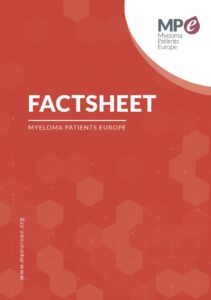What is bortezomib (Velcade®)?
Bortezomib is a cancer medicine approved in Europe in 2012 for the treatment of adult patients with myeloma in the following situations:
- Patients untreated previously who cannot receive high dose of chemotherapy with an autologous stem cell transplantation. In this case, bortezomib is used in combination with melphalan and prednisone (VMp).
- Patients untreated previously who are eligible for high-dose chemotherapy and autologous stem cell transplantation. In this case, bortezomib is used in combination with dexamethasone (Vd), or with dexamethasone plus thalidomide (VTd). Patients whose disease is getting worse after at least one other treatment and who have already had, or are unsuitable for, transplant of blood stem-cells. In this case, bortezomib is used alone or in combination with dexamethasone (Vd) or pegylated liposomal doxorubicin (a type of chemotherapy).
How does bortezomib work?
Bortezomib blocks a system within the cells called proteasomes. Proteasomes are large molecules found in cells of the body, and they are involved in the breakdown of damaged or unwanted proteins. Proteasome inhibitors temporarily block their function, stopping them from breaking down unwanted proteins. This causes proteins to build up to toxic levels, killing the myeloma cells. Myeloma cells rely more heavily on proteasomes than normal healthy cells; they are therefore much more sensitive to proteasome inhibitors.
What are the benefits of bortezomib?
Bortezomib has been evaluated in 10 main studies with 4,339 patients with myeloma, being used alone or in combination with other therapies. In many patients groups, these studies show an improved progression free survival, period of time during which the patient has no evidence of progressive disease and has no signs or symptoms of multiple myeloma.
What are the side effects of bortezomib?
The most common side effects during treatment with bortezomib (that are affecting more than 1 in 10 patients) are1:
- peripheral neuropathy (nerve damage in the hands and feet) – the most common
- vomiting
- nausea
- diarrhoea
- constipation
- fatigue (tiredness)
- pyrexia (fever)
- thrombocytopenia (low blood platelets count)
- anaemia (low red blood cell counts)
- neutropenia (low levels of neutrophils, a type of white blood cell )
- headache
- paraesthesia (sensations of pins and needles)
- decreased appetite
- dyspnoea (difficulty breathing)
- rash
- herpes zoster (shingles)
- myalgia (muscle pain)
The most serious adverse reactions include heart failure, tumour lysis syndrome (complications due to the quick and massive destruction of cancer cells), pulmonary hypertension (high blood pressure in the arteries of the lungs), posterior reversible encephalopathy syndrome (a reversible brain disorder), acute diffuse infiltrative pulmonary disease (a severe lung problem), and autonomic neuropathy (damage to nerves controlling organs).
Who should not receive bortezomib?
Bortezomib must not be used by patients with any of the following conditions: acute diffuse infiltrative pulmonary disease (a type of lung disease) or pericardial disease (disease affecting the sac that surrounds the heart).
How and when is bortezomib given?
Bortezomib can be injected into a vein (intravenous) or under the skin (subcutaneously). Intravenous bortezomib has fallen out of favour, therefore you will commonly see bortezomib 3.5 mg given subcutaneously into the abdomen or the thigh.
Bortezomib is given in treatment cycles of three to six weeks, depending on whether it is given alone or in combination with other myeloma medicines. In each cycle, there are at least 72 hours between one dose of bortezomib and the next one.
When severe side effects appear, the dose should be adjusted or the treatment could be suspended or delayed.
References
- European Medicines Agency. Velcade® (bortezomib) European public assessment report (EPAR) – http://www.ema.europa.eu/docs/en_GB/document_library/EPAR_-_Summary_for_the_public/human/000539/WC500048136.pdf – last updated 1/2015.
- Manufacturer’s product information: http://www.velcade.com/
Rajkumar SV, Kumar S. Multiple Myeloma: Diagnosis and Treatment. Mayo Clin Proc. 2016;91(1):101–19.
